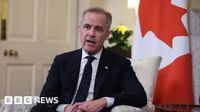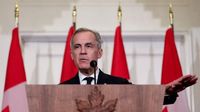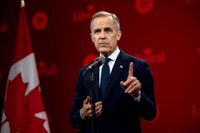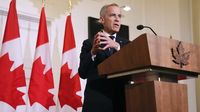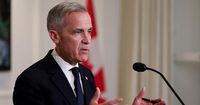Mark Carney Calls Snap Election Amid U.S. Trade Tensions
New Liberal leader poised to face off against Conservative rival Pierre Poilievre
TORONTO (AP) — Newly sworn Canadian Prime Minister Mark Carney is set to call a snap federal election on Sunday, March 23, 2025, with the vote anticipated for April 28, 2025, according to multiple sources familiar with the discussions. This upcoming election marks a significant transition as Carney, who was sworn in as Prime Minister on March 14, 2025, steps into a leadership role following the resignation of former Prime Minister Justin Trudeau.
The announcement to dissolve Parliament, which Carney will seek with Governor-General Mary Simon, is expected to trigger a five-week campaign period. The urgency of the decision stems from rising trade tensions with the United States, primarily incited by President Donald Trump’s recent threats towards Canada.
After Trump imposed a 25% tariff on Canadian steel and aluminum, he further announced plans for sweeping tariffs on all Canadian products effective April 2, 2025. These actions have stirred significant unrest in Canada, prompting a surge in nationalist sentiments and a reevaluation of trade stability with the United States.
Managing these tensions will be a primary focus of Carney’s campaign. The former Bank of Canada and Bank of England governor brings a wealth of experience in navigating economic crises, most notably during the 2008 financial collapse. He faces formidable competition in the form of Conservative leader Pierre Poilievre, who previously enjoyed a lead in polls before the current crisis unfolded.
Sources indicate that the political landscape shifted dramatically after Trudeau's resignation in January following declining approval ratings. Many Canadians expressed anger at Trump’s divisive comments suggesting Canada might be “the 51st state,” leading to backlash at sporting events and an increasing reluctance to purchase American products.
Carney's ascent to leadership comes at a critical time; he aims to convince Canadians that he is best equipped to tackle the challenges arising from Trump’s trade policies. He proposes maintaining reciprocal tariffs if the U.S. continues its aggressive stance towards Canadian goods not covered by the Canada-United States-Mexico Agreement (CUSMA).
Since his election as leader of the Liberal Party on March 9, Carney has witnessed a surge in support, particularly as Canadians rally behind their identity in the face of U.S. threats. A quick election could benefit him, as voters might be more focused on current national discourse surrounding the trade war.
Polls show that while the Liberals previously trailed the Conservatives by a substantial margin, the outlook has tightened significantly. Recent surveys indicate a dead heat between the two parties as Canadians prepare to head to the polls, with estimates suggesting a slight edge for the Liberals.
As Carney prepares for campaign strategies, he hopes to solidify his image as a leader who can rival Trump and effectively address Canadian economic concerns. Recent meetings with leaders from Britain and France during his first official trip abroad hint at his inclination to strengthen international alliances while navigating the uncertain waters of U.S. relations.
Trump’s behavior has hampered Poilievre, who is keen to frame his campaign around “Canada First” ideals while distancing himself from the U.S. President’s controversial remarks. The Conservative leader has stated he would pursue energy independence and reduce reliance on American imports, potentially regaining ground as Canadians assess their options.
As the snap election date draws nearer, the stakes heighten for both Carney and Poilievre. The recent political turbulence has transformed a once certain Conservative victory into a heated contest, suggesting that the electoral outcome could hinge on individual perceptions of leadership during unprecedented times.
Only time will tell how these dynamics will unfold as Canadians prepare to weigh their political choices in this evolving narrative marked by external pressures from the United States and internal calls for sovereignty and stability.
